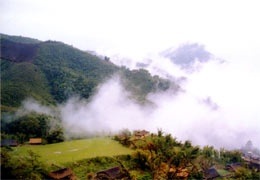MEGHALAYA
Meghalaya border is just 16 Kms. from the Guwahati Railway station.
 No
proper signs will greet you to inform that the state of Meghalaya
has started but instead, nice roads with steady incline and
forest on both sides will. No
proper signs will greet you to inform that the state of Meghalaya
has started but instead, nice roads with steady incline and
forest on both sides will.
You will be amazed to see everything around you change in
just a span of one Kilometer.
The ride from here onwards gets better and better, roads keep
on taking you up to a higher altitude, with small huts made
of bamboo and curious locals peeping out from the windows.
Meghalaya is not called Adobe of Clouds and Land of Rain
Clouds without a reason; all throughout the ride the clouds
offer a kaleidoscope view of the mountain ranges.
20 kms. before Shillong, capital of Meghalaya is Umian lake,
amidst the beautiful surrounding are the huge hoardings welcoming
you to the state, letting you know the history, culture and
places of interest, all put up by the Tourism Ministry of
Meghalaya.
 Though
this region is still in turmoil for it's slow economic growth
and traveling in the night is still not advisable, even though
it is now considered the safest state in the North East after
Arunachal Pradesh. But it was nice to see the government realizing
that tourism can boost the growth of the state and hence going
all out to make you feel at home. Though
this region is still in turmoil for it's slow economic growth
and traveling in the night is still not advisable, even though
it is now considered the safest state in the North East after
Arunachal Pradesh. But it was nice to see the government realizing
that tourism can boost the growth of the state and hence going
all out to make you feel at home.
Ride from the Umian Lake gets steeper giving a bird's eye
view of the lake below, as we moved up temperatures went down.
At Shillong the temperature was freezing 11 degrees that too
in the month of March, which is Summer time in India.
Streets in Shillong are narrow with lot of one ways making
parking a big problem.
Shillong will remind one of Shimla (Capital of Himachal Pradesh,
a Northern State of India), old colonial style architecture
and lots of churches.
Shillong is more of a hill station than a city, stay here
is pleasant, but unlike Guwahati there are no ATM facilities
and hotels are very expensive.
Meghalaya is home to three tribes, Jainti (the smallest community)
Garo, which inhabits the western side of the state, and Khasi's,
which inhabitate the eastern side.
The tribes follow matrilineal society, the property is passed
on to females rather than males, the tribal palace we went
to had a Queen, but her husband was not addressed as King,
instead he was called Chief.
CHERRAPUNJI..(read on)
^Top
|